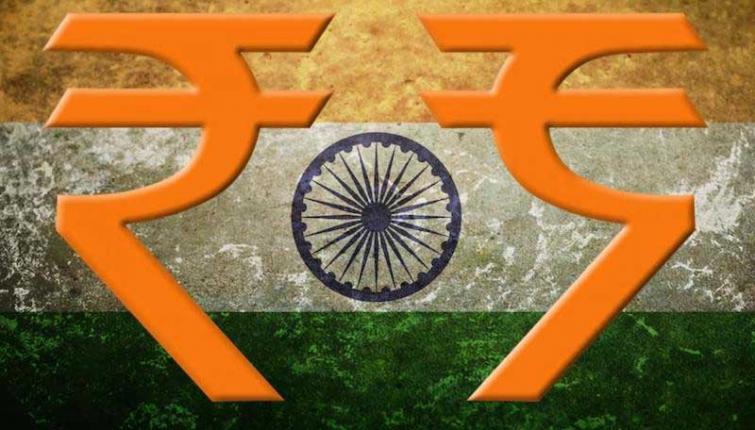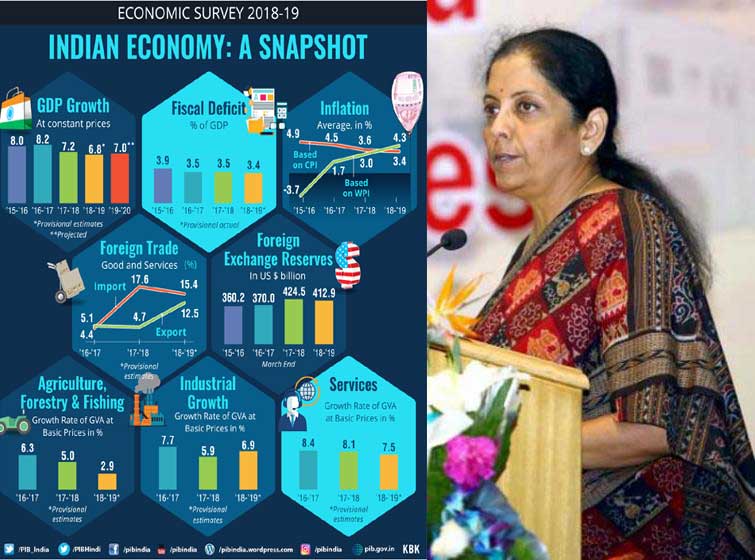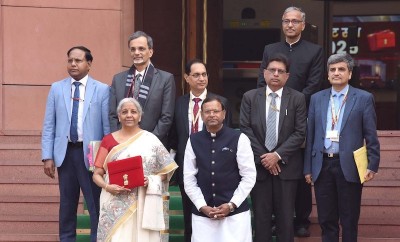
Nirmala Sitharaman tables Economic Survey report, calls for sustained 8% growth rate; India forecasts 7% GDP growth
New Delhi, July 4 (IBNS): A day ahead of the Union Budget, Finance Minister Nirmala Sitharaman on Thursday tabled the Economic Survey which has given a call for a sustained 8% growth rate for India to become a USD 5 Trillion Economy by 2024-25. The government forecast the real GDP growth for the year to 7% percent this year, while being wary of checking the fiscal deficit.
The survey says that it “makes the case for investment, especially private investment as key driver, that drives demand, creates capacity, increases labour productivity, introduces new technology and generate jobs”. The survey suggests that “Exports must form an integral part of the growth model because higher savings preclude domestic consumption as the driver of final demand.”
The union government on Thursday projected the real GDP growth for the year 2019-20 at 7 per cent on the back of anticipated pickup in the growth of investment and acceleration in the growth of consumption.
GDP to grow at 7% in 2019-20 due to growth of investment & consumption Service exports enhanced to Rs. 14.389 lac cr in 2018-19 from Rs. 0.746 lac cr in 2000-01. India’s share in world service exports increased from 2% in 2005 to 3.5 % in 2017 India’s foreign exchange reserves comfortably placed at US $ 422.2 billion in June 2019. FDI inflows growing at a high rate since 2015-16 in services, automobiles and chemicals Credit to both, large and micro, small and medium enterprises has seen pickup in growth Growth in the industry accelerated during 2018-19 due to improved manufacturing and construction activity
Shifting gears: Private Investment as the Key Driver of Growth, Jobs, Exports and Demand
- Survey states that pathways for trickle-down opened up during the last five years; and benefits of growth and macroeconomic stability reached the bottom of the pyramid.
- Sustained real GDP growth rate of 8% needed for a $5 trillion economy by 2024-25.
- “Virtuous Cycle” of savings, investment and exports catalyzed and supported by a favorable demographic phase required for sustainable growth.
- Private investment- key driverfor demand, capacity, labor productivity, new technology, creative destruction and job creation.
- Survey departs from traditional Anglo-Saxon thinking by viewing the economy as being either in a virtuous or a vicious cycle, and thus never in equilibrium.

Policy for Real People, Not Robots: Leveraging the Behavioral Economics of “Nudge”
- Decisions by real people deviate from impractical robots theorized in classical economics.
- Behavioral economics provides insights to ‘nudge’ people towards desirable behavior.
-
Key principles of behavioral economics:
- Emphasizing the beneficial social norm.
- Changing the default option.
- Repeated reinforcements.
- Using insights from behavioral economics to create an aspirational agenda for social change:
- From ‘Beti Baco Beti Padhao’ to ‘BADLAV’ (Beti Aapki Dhan Lakshmi Aur Vijay Lakshmi).
- From ‘Swachh Bharat’ to ‘Sundar Bharat’.
- From ‘Give it up” for the LPG subsidy to ‘Think about the Subsidy’.
- From ‘Tax evasion’ to ‘Tax compliance’.
Nourishing Dwarfs to become Giants: Reorienting policies for MSME Growth
- Survey focuses on enabling MSMEs to grow for achieving greater profits, job creation and enhanced productivity.
- Dwarfs (firms with less than 100 workers) despite being more than 10 years old, account for more than 50% of all organized firms in manufacturing by number.
- Contribution of dwarfs to employment is only 14% and to productivity is a mere 8%.
- Large firms (more than 100 employees) account for 75% employment and close to90% of productivity despite accounting for about 15% by number.
-
Unshackling MSMEs and enabling them to grow by way of:
- Asunset clause of less than 10 years, with necessary grand-fathering, for all size-based incentives.
- Deregulating labor law restrictions to create significantly more jobs, as evident from Rajasthan.
- Re-calibrating Priority Sector Lending (PSL) guidelines for direct credit flow to young firms in high employment elastic sectors.
- Survey also focuses on service sectors such as tourism, with high spillover effects on other sectors such as hotel & catering, transport, real estate, entertainment etc., for job creation.
Data “Of the People, By the People, For the People”
- Society’s optimal consumption of data is higher than ever given technological advances in gathering and storage of data.
- As data of societal interest is generated by the people, data can be created as a public good within the legal framework of data privacy.
- Government must intervene in creating data as a public good, especially of the poor and in social sectors.
- Merging the distinct datasets held by the Government already would generate multiple benefits.
Ending Matsyanyaya: How to Ramp up Capacity in the Lower Judiciary
- Delays in contract enforcement and disposal resolution are arguably now the single biggest hurdle to the ease of doing business and higher GDP growth in India.
- Around 87.5 per cent of pending cases are in the District and Subordinate courts.
- 100 per cent clearance rate can be achieved by filling out merely 2279 vacancies in the lower courts and 93 in High Courts.
- States of Uttar Pradesh, Bihar, Odisha and West Bengal need special attention.
- Productivity improvements of 25 percent in lower courts, 4 percent in High Courts and 18 percent in Supreme Court can clear backlog.
Support Our Journalism
We cannot do without you.. your contribution supports unbiased journalism
IBNS is not driven by any ism- not wokeism, not racism, not skewed secularism, not hyper right-wing or left liberal ideals, nor by any hardline religious beliefs or hyper nationalism. We want to serve you good old objective news, as they are. We do not judge or preach. We let people decide for themselves. We only try to present factual and well-sourced news.







